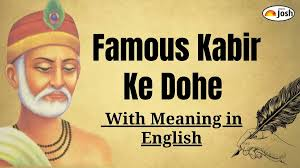Introduction
Kabir Das, the 15th-century poet-saint, continues to inspire millions with his simple yet profound wisdom. His dohe (couplets) are more than poetry they are life lessons wrapped in few words, making complex truths accessible. Kabir’s verses address morality, spirituality, social harmony, and the inner journey of the soul.
Even today, people across India and the world reflect on his words to find guidance, peace, and clarity. This article dives deep into some famous Kabir Das dohe, their meanings, and how we can apply these teachings in our daily lives.
Let’s explore Kabir’s timeless wisdom, understand the essence of his couplets, and see how they remain relevant centuries later.
1. Who Was Kabir Das?
Kabir Das was a mystic poet and saint born in 1440 in Varanasi, India. He belonged to a time when society was divided by caste and religion. Kabir’s teachings emphasized unity, love, and devotion to God beyond rituals.
He used dohe as his primary form of expression. These short couplets were simple enough for common people to remember, yet deep enough for scholars to ponder. Kabir’s language was plain, avoiding complicated Sanskrit. This accessibility made his wisdom universal, crossing barriers of class, caste, and religion.
Kabir’s work influenced both the Bhakti and Sufi movements. His focus was always on inner truth, not external rituals. In his dohe, he often used metaphors from daily life to make philosophical concepts easy to understand.
2. What Are Dohe?
A doha is a two-line couplet. It is usually 24 syllables long, split into two halves. In the first line, the poet presents an idea, and in the second line, he explains or concludes it.
Kabir Das used dohe to convey deep spiritual lessons in a short, memorable format. Because of their brevity, dohe can be remembered easily and applied in daily life. They are a bridge between literature and philosophy, making complex concepts simple.
For example, Kabir often used metaphors like “water,” “mirror,” or “lamp” to symbolize knowledge, self-realization, and enlightenment. This makes his dohe relevant across cultures and generations.
3. Famous Kabir Das Dohe and Their Meanings
Here are some of the most celebrated Kabir Das dohe and what they teach us:
Doha 1:
“Dukh Mein Sumiran Sab Kare, Sukh Mein Kare Na Koi”
- Meaning: People remember God only in pain, not in happiness. Kabir urges constant remembrance and gratitude, regardless of circumstances.
Doha 2:
“Jyon Jyon Dhan Aaye, Tyon Tyon Bhul Jaye”
- Meaning: Material wealth can make people forget spiritual values. Kabir highlights the importance of staying grounded.
Doha 3:
“Bura Jo Dekhan Main Chala, Bura Na Milya Koye”
- Meaning: When you search for faults in others, you often find none. Self-reflection is key before judging.
These couplets, though short, carry deep philosophical and ethical lessons that can transform our perspectives.
4. Life Lessons From Kabir Das Dohe
Kabir Das’s dohe are not just poetic they are practical life lessons. For example:
- Value Inner Peace: Happiness is not in material wealth but in understanding oneself.
- Practice Self-Reflection: Judge yourself before judging others.
- Consistency in Faith: Remember God in both joy and sorrow.
- Humility and Simplicity: True wisdom is humble and does not seek attention.
Applying these lessons can improve relationships, reduce stress, and enhance overall well-being. Kabir’s teachings remind us that spirituality and morality are accessible to everyone, not just scholars or saints.
5. Kabir’s Teachings on Love and Humanity
Kabir Das often spoke about love beyond religion. One famous doha says:
“Prem na karo tulsi, prem karo mann”
- Meaning: Love is not about rituals or names; it is about the heart’s sincerity.
He believed that all humans are connected through love. In today’s divisive world, his words urge unity, kindness, and empathy. Kabir’s emphasis on human values over ritualistic practices continues to inspire social reformers and spiritual seekers alike.
6. Spiritual Significance of Kabir Das Dohe
Kabir’s dohe often point to the inner spiritual journey. He emphasizes self-realization, detachment, and the quest for truth. One popular doha says:
“Moko Kahan Dhundhe Re Bande, Main To Tere Paas Mein”
- Meaning: God is not far away; He is within you. Seek inwardly, not externally.
This teaching encourages meditation, introspection, and mindfulness. It shifts focus from external rituals to personal spiritual growth. Kabir’s philosophy is simple: Truth is within, and realizing it leads to liberation.
7. Social Relevance of Kabir Das Dohe
Kabir Das was a social reformer. Many of his dohe criticize caste discrimination, hypocrisy, and blind rituals. For instance:
“Jati Na Puchho Sadhu Ki, Puchho Jyan Ki Baat”
- Meaning: Don’t judge a saint by caste; judge by wisdom and actions.
In modern times, these teachings are relevant for promoting equality, tolerance, and justice. Kabir’s wisdom encourages thinking beyond superficial differences and valuing character over social labels.
8. Kabir Das Dohe for Daily Motivation
Kabir’s couplets can serve as daily reminders for motivation and personal growth. For example:
“Kal Kare So Aaj Kar, Aaj Kare So Ab”
- Meaning: Don’t procrastinate; act today for a better tomorrow.
This doha teaches time management, responsibility, and the power of present action. By integrating such lessons daily, we can cultivate discipline and focus while staying spiritually grounded.
9. Kabir Das Dohe in Education
Kabir Das’s dohe are also valuable teaching tools. Teachers use them to:
- Encourage moral thinking in children
- Simplify philosophical concepts
- Promote language and literary appreciation
These short, rhythmic couplets are easy to memorize, making learning fun and impactful. Students not only learn poetry but also absorb ethical and spiritual lessons in a natural way.
10. Kabir Das’s Impact on Literature and Philosophy
Kabir’s influence stretches across literature, music, and philosophy. His dohe inspired poets, saints, and philosophers in India and abroad. They are part of Bhakti and Sufi traditions, influencing writers like Tulsidas and Mirabai.
The simplicity of his language, combined with the depth of meaning, makes his work timeless. Even modern writers reference Kabir to illustrate morality, devotion, and human values in their works.
11. How to Apply Kabir Das Dohe in Modern Life
Applying Kabir’s wisdom doesn’t require religious rituals. Here are practical steps:
- Practice mindfulness: Reflect on your actions daily.
- Embrace simplicity: Focus on needs, not unnecessary desires.
- Be compassionate: Treat others with love and respect.
- Seek knowledge: Value inner growth over material gain.
These small steps make life calmer, more meaningful, and spiritually rich, echoing Kabir’s age-old advice.
FAQs About Famous Kabir Das Dohe
Q1: Who was Kabir Das?
A: Kabir Das was a 15th-century poet and saint known for his simple yet profound teachings.
Q2: What is a doha?
A: A doha is a two-line poetic couplet with a deep moral or spiritual lesson.
Q3: Why are Kabir Das dohe still popular?
A: They are simple, memorable, and teach universal life lessons that transcend time.
Q4: Can Kabir’s dohe be applied in daily life?
A: Yes. They offer guidance on love, humility, mindfulness, and personal growth.
Q5: Did Kabir Das belong to any religion?
A: Kabir transcended religious boundaries, focusing on devotion to God and universal truth.
Q6: How many dohe did Kabir write?
A: Exact numbers vary, but thousands of dohe are attributed to him in collections like the Bijak and Kabir Granthavali.
Conclusion: Embracing Kabir Das’s Timeless Wisdom
Kabir Das’s famous dohe are not just ancient poetry they are life lessons that remain relevant today. They teach us about love, humility, self-reflection, and inner peace. Applying his wisdom can transform relationships, mindset, and spirituality.
By reading, reflecting, and practicing these couplets, anyone can connect with Kabir’s timeless insights. Share these dohe, discuss them with friends, and allow Kabir’s words to guide your actions. After all, simple words can spark profound change.
Embrace Kabir Das’s wisdom today, and let his dohe light the path to a more meaningful, thoughtful, and compassionate life.







